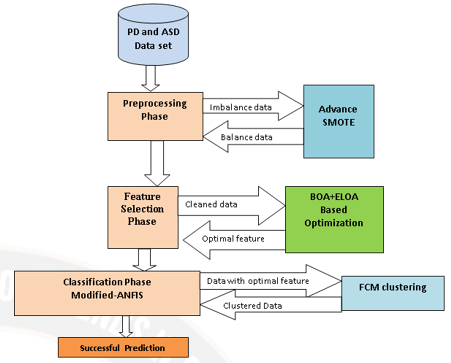Improving Accuracy of Integrated Neuro-Fuzzy Classifier with FCM based Clustering for Diagnosis of Psychiatric Disorder
Main Article Content
Abstract
Parkinson’s disease (PD) is a progressive neurodegenerative disorder. Autism spectrum disorder (ASD) is a neurodevelopment disorder. Clinical decision-making process is complex. Due to complex nature of disease sign and its symptoms clinical decision making may lead to misclassification. To deal with such complex medical problems methods or approaches of soft computing play an important role. This paper will focus on presenting an integrated Neuro-fuzzy model. This integrated model has the learning strength of neural network and knowledge representation ability of fuzzy logic. Modified Adaptive Neuro –Fuzzy inference system (M-ANFIS) is used here for classification and predication. Here Fuzzy C-mean (FCM) Clustering is used first to make classes of data before presenting in to ANFIS. This FCM based class will reduce the classifier computational overhead. Precision error and recall, F-measure and accuracy matrices are used to compare the experimental results with other classic methods.
Article Details
References
Abiyev, R. H., and Abizade, S. (2016). Diagnosing Parkinson's diseases using fuzzy neural system. Comput. Mathe. Methods Med. 2016:1267919. doi: 10.1155/2016/1267919.
Aich, S., Kim, H., younga, K., Hui, K. L., Al-Absi, A. A., and Sain, M. (2019). “A supervised machine learning approach using different feature selection techniques on voice datasets for prediction of Parkinson's disease,” in 2019 21st International Conference on Advanced Communication Technology (ICACT) (PyeongChang), 1116–1121. doi: 10.23919/ICACT.2019.8701961.
Ali, L., Khan, S. U., Arshad, M., Ali, S., and Anwar, M. (2019a). “A multi-model framework for evaluating type of speech samples having complementary information about Parkinson's disease,” in 2019 International Conference on Electrical, Communication, and Computer Engineering (ICECCE) (Swat), 1–5. doi: 10.1109/ICECCE47252.2019.8940696.
Gunduz, H. (2019). Deep learning-based parkinson's disease classification using vocal feature sets. IEEE Access 7, 115540–115551. doi: 10.1109/ACCESS.2019.2936564.
Karapinar Senturk, Z. (2020). Early diagnosis of Parkinson's disease using machine learning algorithms. Med. Hypoth. 138:109603. doi: 10.1016/j.mehy.2020.109603.
Khan, M. M., Mendes, A., and Chalup, S. K. (2018). Evolutionary Wavelet Neural Network ensembles for breast cancer and Parkinson's disease prediction. PLoS ONE 13:e0192192. doi: 10.1371/journal.pone.0192192.
Frid, A., Safra, E. J., Hazan, H., Lokey, L. L., Hilu, D., Manevitz, L., et al. (2014). “Computational diagnosis of Parkinson's disease directly from natural speech using machine learning techniques,” in 2014 IEEE International Conference on Software Science, Technology and Engineering (Ramat Gan), 50–53. doi: 10.1109/SWSTE.2014.17.
Baby, M. S., Saji, A. J., and Kumar, C. S. (2017). “Parkinsons disease classification using wavelet transform based feature extraction of gait data,” in 2017 International Conference on Circuit, Power and Computing Technologies (ICCPCT) (Kollam), 1–6. doi: 10.1109/ICCPCT.2017.8074230.
Tahir, N. M., & Manap, H. H. (2012). Parkinson disease gait classification based on machine learning approach. Journal of Applied Sciences (Faisalabad), 12(2), 180-185.
Solana-Lavalle, G., Galán-Hernández, J. C., & Rosas-Romero, R. (2020). Automatic Parkinson disease detection at early stages as a pre-diagnosis tool by using classifiers and a small set of vocal features. Biocybernetics and Biomedical Engineering, 40(1), 505-516.
El-Ansary, A., Hassan, W. M., Daghestani, M., Al-Ayadhi, L., & Ben Bacha, A. (2020). Preliminary evaluation of a novel nine-biomarker profile for the prediction of autism spectrum disorder. PLoS One, 15(1), e0227626.
Goel, N., Grover, B., Gupta, D., Khanna, A., & Sharma, M. (2020). Modified grasshopper optimization algorithm for detection of autism spectrum disorder. Physical Communication, 41, 101115.
https://archive.ics.uci.edu/ml/datasets/Parkinson.
https://archive.ics.uci.edu/ml/datasets/Autistic_Spectrum_Disorder.
Chawla, N. V., Bowyer, K. W., Hall, L. O., & Kegelmeyer, W. P. (2002). SMOTE: synthetic minority over-sampling technique. Journal of artificial intelligence research, 16, 321-357.
Chandrashekar, G., & Sahin, F. (2014). A survey on feature selection methods. Computers & Electrical Engineering, 40(1), 16-28.
Arora, S., & Singh, S. (2019). Butterfly optimization algorithm: a novel approach for global optimization. Soft Computing, 23(3), 715-734.
Yazdani, M., & Jolai, F. (2016). Lion optimization algorithm (LOA): a nature-inspired metaheuristic algorithm. Journal of computational design and engineering, 3(1), 24-36.
Benmouiza, K., Cheknane, A. (2019). Clustered ANFIS network using fuzzy c-means, subtractive clustering, and grid partitioning for hourly solar radiation forecasting. Theor Appl Climatol 137, 31–43. https://doi.org/10.1007/s00704-018-2576-4.
Pal, N. R., Pal, K., Keller, J. M., & Bezdek, J. C. (2005). A possibilistic fuzzy c-means clustering algorithm. IEEE transactions on fuzzy systems, 13(4), 517-530.
Wu Y, Duan H, Du S.(2015). Multiple fuzzy c-means clustering algorithm in medical diagnosis. Technol Health Care.;23 Suppl 2:S519-27. doi: 10.3233/THC-150989.
Chowdhary CL, Mittal M, P K, Pattanaik PA, Marszalek Z. (2020). An Efficient Segmentation and Classification System in Medical Images Using Intuitionist Possibilistic Fuzzy C-Mean Clustering and Fuzzy SVM Algorithm. Sensors (Basel);20(14):3903. doi: 10.3390/s20143903.
Wei, M., Bai, B., Sung, A. H., Liu, Q., Wang, J., & Cather, M. E. (2007). Predicting injection profiles using ANFIS. Information Sciences, 177(20), 4445-4461.

